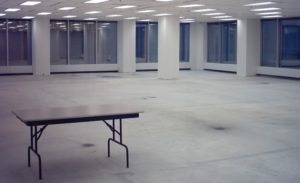In order to solve the problem, we started with the people. Who, from the rest of the institution, needed to grow or consolidate. Where would they be best located to grow in the future?
Previous planning work found that administrative groups were located across campus, creating inefficiencies, and that their offices tended to be in main floor space. While this is convenient for staff, this prime real estate should be turned over to students for gathering and study space. Knowing that improving the student experience is always in the institution’s best interest, it followed that consolidating admin away from the main floor was a priority in the repurposing effort.

The Continuing Education department had two problems: finding classrooms and being spread apart. They worked on the fringes of the institute for years, taking over the campus on evenings and weekends. Working around the typical academic schedule meant they had a hard time booking emerging classes at a moment’s notice. As a result, they weren’t as nimble as they knew they could be. ConEd offices were also split in two- with one of the groups working off campus. In order to maximize the benefit of a move, two solutions needed to be delivered. Dedicated classrooms for real-time booking and consolidating all of the staff in one building.
Making a plan
Five and 10-year growth plans were developed to define how much space each group needed. Blocking planning was developed for three scenarios: use the tower, use the old department store, or use both. Each option could have worked, so detailed space planning was completed for each option. As a result of the planning, it was clear that both buildings should kept and repurposed.
Knowing that both spaces could be used well, we developed “bronze, silver and gold” renovation options. Bronze is the least amount of work required to keep a building going for 5-7 years. This level includes limited renovation to public space. Silver increases the life of the building systems and includes renovations to make the space more useful. Gold is a full renovation, which turns out to be at least the same price as new construction.
A little of column A, a little of column B
The solution: a bit of a hybrid of all the options. The former department store ended up with a renovation that improved social spaces, solved many of the “behind-the-scenes” problems improving the quality of life for students and staff and left most of the classrooms as-is. The tower will be phased. The top floors received full renovations, the office spaces on the lower floors received limited upgrades and the whole building got the same behind-the-scenes” upgrade as the department store. Over time, the building can continue to be fully renovated, expanding its lifespan to that of a new building, without the upfront cost.
